I apologize for not posting about January's bird count. I was busy and sick and just didn't have the time. I will post a few photos here of some of the highlights. Early in the morning, on the trail behind the nature center, I saw a large flock of American Goldfinches (I'd never seen them at the lagoon before) and a female Orange Bishop (a weaver finch from Africa that has become established in parts of California). We also saw a flock of Bushtits that, surprisingly, stayed still long enough for me to take a few pictures. There was an entirely black domestic Mallard swimming around the lagoon; it was very pretty. There was also a large group of Northern Pintails and a huge flock of gulls (and a few Brown Pelicans among them). The first two photos are of the American Goldfinches, the third is the Orange Bishop, the fourth is a Bushtit, the fifth is the Mallard, the sixth is the group of Northern Pintails, and the seventh is a small part of the flock of gulls (and three of the pelicans).
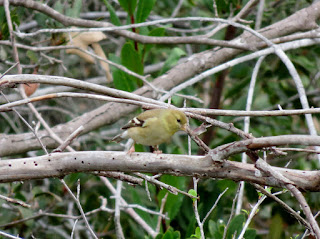 |
| American Goldfinch |
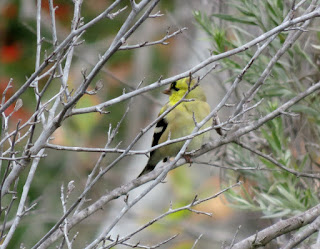 |
| American Goldfinch |
 |
| Orange Bishop |
 |
| Bushtit |
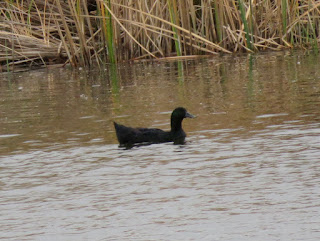 |
| Mallard (Domestic) |
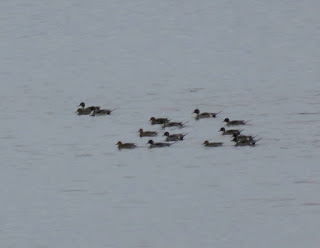 |
| Northern Pintails |
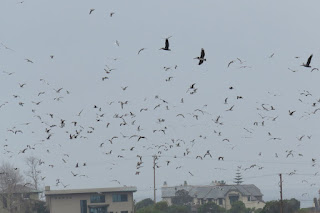 |
| Gulls and Brown Pelicans |
Yesterday was the February bird count. While last month was fairly cloudy, this month was bright, clear, and sunny. Below are four views around the lagoon.
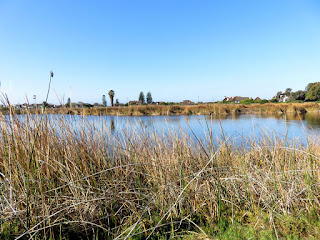
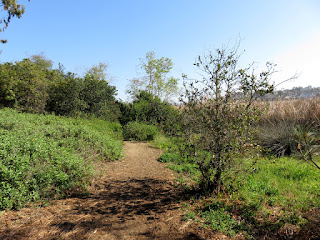
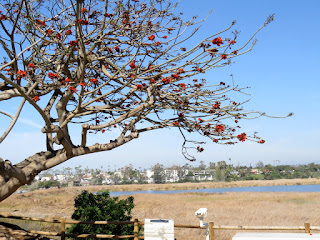

Before heading onto the trail behind the nature center, I walked along the highway to look for birds in the water and reeds beside the road. As I was walking, I was surprised by a loud clacking call close by. A Ridgway's Rail poked it's head out of the reeds. It disappeared before I could take picture, but I could hear it rustling, and occasionally it called. I walked along the road with it and eventually reached the end of the reeds. I started to make a "pst" sound to see if it might be curious and come out. It did walk out into the open and stood there looking at me. I'd never seen a Ridgway's Rail so close before; it was very exciting. Ridgway's Rails were previously considered a subspecies of the Clapper Rail, but have now been declared their own species. They live along the Pacific Coast in salt and freshwater marshes. The Ridgway's Rail is grayish-brown overall with dark streaking on the back, white streaking on the belly, a reddish-brown chest, and a white rump. It has a bright orange bill and orange legs. Below are two photos of the Ridgway's Rail.
 |
| Ridgway's Rail |
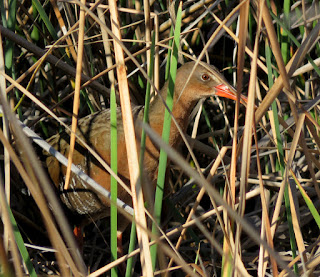 |
| Ridgway's Rail |
In the morning, there were a few Gadwall floating around on the lagoon. Below is a pair of them (the female is on the left, the male on the right).
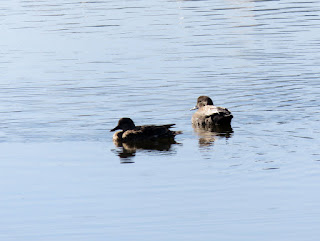 |
| Gadwall |
We also saw a pair of Western Bluebirds checking out the bluebird house in front of the nature center. Below are two photos. The first is of the female sitting on the birdhouse. The second is of the male sitting in another part of the tree.
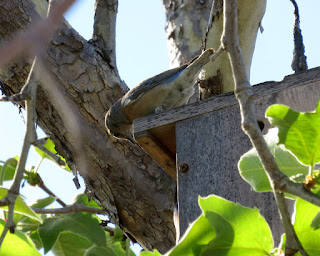 |
| Western Bluebird |
 |
| Western Bluebird |
We saw quite a few Cedar Waxwings. They were singing very loudly and flying around or perching in flocks. Below is one of them.
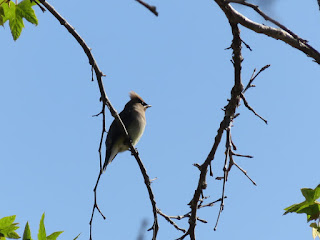 |
| Cedar Waxwing |
There were also a few small groups of Lesser Goldfinches. Below is a male that was singing high up in a tree.
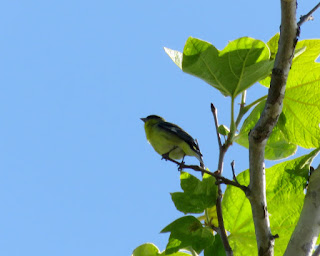 |
| Lesser Goldfinch |
The Song Sparrows were also singing from every bush. Below is one of them.
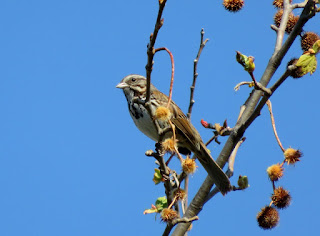 |
| Song Sparrow |
We were very surprised to see a large flock of American White Pelicans. They would fly up into the air and soar around for a while before settling back down on the lagoon. I don't remember seeing so many at the lagoon before; there were at least twenty-five of them. Below are three photos of the pelicans.
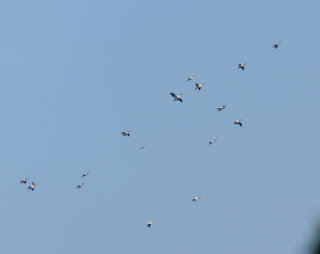 |
| American White Pelicans |
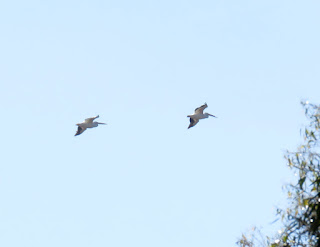 |
| American White Pelicans |
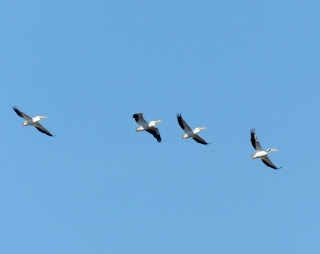 |
| American White Pelicans |
There weren't too many hummingbirds yesterday. There were a few Anna's and Allen's here and there, but there didn't seem to be as many as usual. Below are two photos of a very shiny male Allen's Hummingbird.
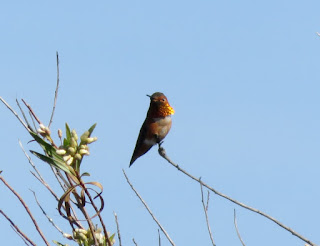 |
| Allen's Hummingbird |
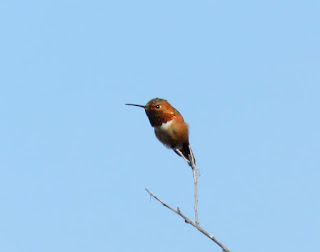 |
| Allen's Hummingbird |
There were quite a few Northern Shovelers on the lagoon. It seemed like there was always another flock of them coming in to land. Below are two photos of the Northern Shovelers.
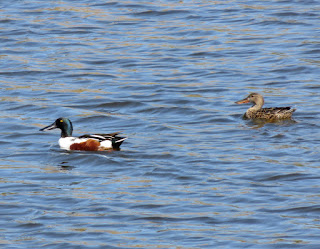 |
| Northern Shovelers |
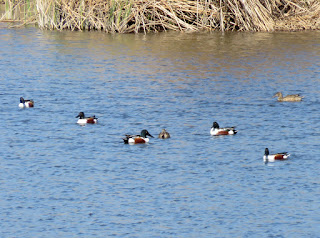 |
| Northern Shovelers |
There were several Western Grebes around, but only one Clark's. Below is the Clark's Grebe (notice the black is above the eye).
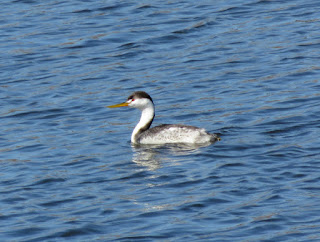 |
| Clark's Grebe |
There was a Great Blue Heron sitting in the reeds, preening itself. There was one sitting in the exact same spot last month doing the exact same thing; perhaps it was the same one. Below is the heron.
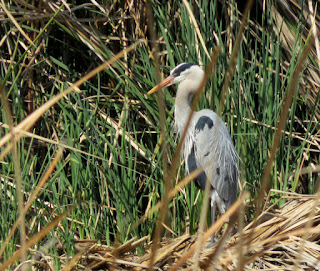 |
| Great Blue Heron |
There were quite a few warblers hopping around, though not many different species. The most abundant were the Yellow-rumped Warblers (there are always huge numbers of them in the winter), followed by the Common Yellowthroats. There were also a few Orange-crowned Warblers and one Townsend's Warbler. Below is a photo of the one of the Common Yellowthroats.
 |
| Common Yellowthroat |